Top attractions in Edinburgh
Edinburgh Castle
National museum of Scotland
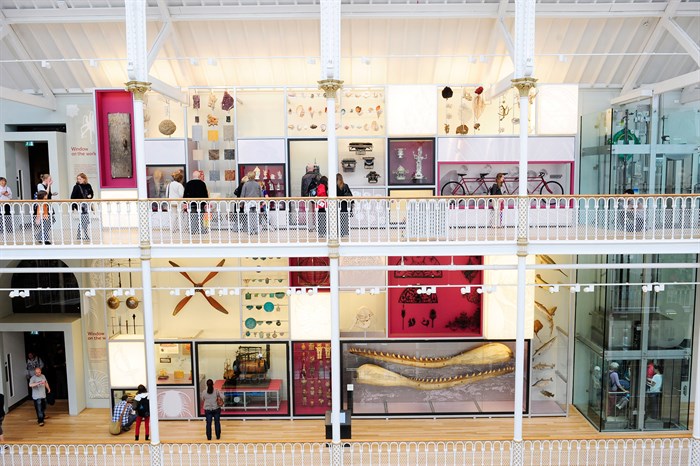
Palace of Holyroodhouse
The Royal Mile
The Whisky Experience
Hotels

The Bonham
The Old Waverley
Restaurants
The Table
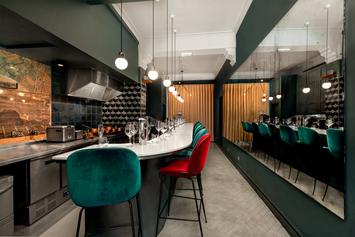
Forage And Chatter



Yes, there indeed is a difference. Holland is not the Netherlands. But why do people know Holland but have almost never heard of the Netherlands?
The Netherlands is the actual name of the country. Although people often refer to it as Holland because Holland has been, and still is, the buzzing west of the Netherlands. The Netherlands are divided into 12 provinces. The most known are North and South Holland. People often muddle them up and Holland becomes the name of the country instead.
History gives us another good reason. In the time of William of Orange and Philip the second, we see that William of Orange, also referred to as William the Silent, was not exactly on good terms with Philip the second. William inherited lands from his cousin. These lands are now known as the Netherlands and Belgium, but at that time they were called the Low Lands. Many different cultures lived there. When Philip got cross with William, William made Amsterdam his base of operations because he knew the area very well. At that time, the Low Lands were in the middle of revolution against the Catholic Church. Philip sent an army to the Low Lands to regain control. William united the people living in the Low Lands under the name of the Dutch Republic and reigned from the province of Holland. Eventually the Republic won the war and became independent with Amsterdam as its capital.
In the 17th century, which is the golden age for the Netherlands, ships of the Republic were seen all over the world. Whenever people asked where the captain of the ship was from, they would answer with the name of their province. This was almost always Holland. But things went sour for the Republic. The only important province was Holland. Holland took care of almost half of the income of the country. On top of that, the Republic was at war with England, France and the German Bishoprics. This year, 1672, is known as Rampjaar (Disaster Year).
Later on, the Netherlands was conquered by Napoleon and became part of France as a unitary state.
It was in the time of Napoleon that North and South Holland were born. Napoleon shaped the Netherlands and split Holland into two separate parts. These parts were reunited after Napoleon’s defeat but Holland was given two governors instead of one. And so, the Netherlands were divided as both governors did what was best for their respective part of Holland. And so, the people decided to split Holland back into two, South and North Holland.
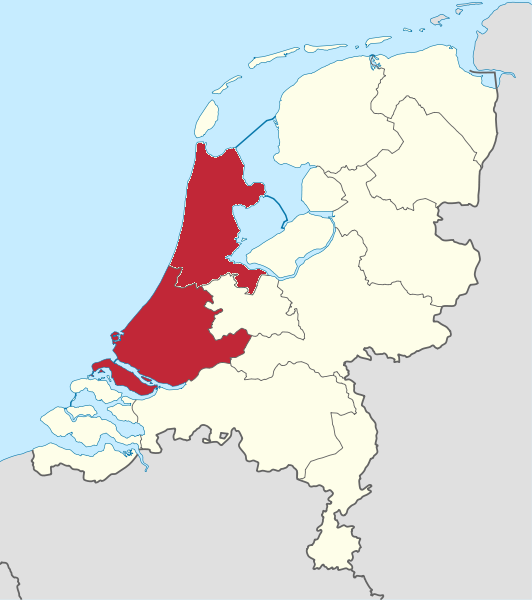
Holland is indicated in red.
To sum it all up, Holland is a part of the Netherlands and consists of two parts. Holland was historically and economically the most known but that does not make all people in the Netherlands someone from Holland. So, people from Holland are part of the Dutch people who live in the Netherlands and not all Dutch people from the Netherlands are from Holland.
If you are considering or indeed have booked a Holland: Tullips and Windmills bike tour with Fresh Eire Adventures you will, no doubt, be interested in maximizing your time in the Netherlands. While most guests opt to visit the well-known West and cities such as Amsterdam, Rotterdam or The Hague, there is so much more to this wonderful country known as Holland. Here, Fresh Eire Adventures intern, Mark Zwerus, who hails from Zwolle in the East, shares with us his top recommendations and insights to visiting and exploring the North-East of the country. Goede reis (have a good trip).
The Kröller Müller museum is home to the second largest Van Gogh collection in the world. Moreover you can also see pieces of art from Pablo Picasso and Piet Mondrian for example. The sculpture garden has over 160 works - a true feast for the eyes. You can walk through the museum at your own pace. If that is not your thing or you would like additional information, an audio tour or a guided tour is available.
Before actually going on one of these fascinating WWII tours, check out the locations on the website. In these informative tours, you get to see the impact the second World War had on the locality. The guides are all locals with lots of knowledge of the surrounding area. During your trip, you will see the astonishing Dutch landscape or an old city with lots of stories to tell. Coffee and tea will be served as part of the trip.
Located in Lelystad, is the aircraft theme park of Aviodrome where one can visit the exhibition of over 100 aircraft. You can also experience being a captain in a flight simulator or actually take flight in a tour to see an aerial overview of the nearby vicinity.

The Dutch are famous for their battles with the water. In Giethoorn however, water is their best friend. This canal city is best navigated by boat and even affords the opportunity to visit one of the nearby lakes. De Oude Aarde Fossil Museum takes you back in time and shows the beauty of the earth through gems and fossils in shapes and colors that you would not think existed.
This Italian restaurant is small and picturesque in the buzzing city center of Deventer. This uniquely furnished restaurant is located within the Waag, a historically significant building which was used as a venue to weigh witches during the infamous trials. Everything is homemade to the highest standards. The restaurant itself is exceptionally atmospheric.
La Cubanita is one of the most popular restaurants in the Netherlands at the moment. Their diverse menu features a variety of tapas. Magnificent food and excellent service make La Cubanita definitely one of the best and most unique restaurants the Netherlands has to offer. Plus their quirky ordering system will be memorable.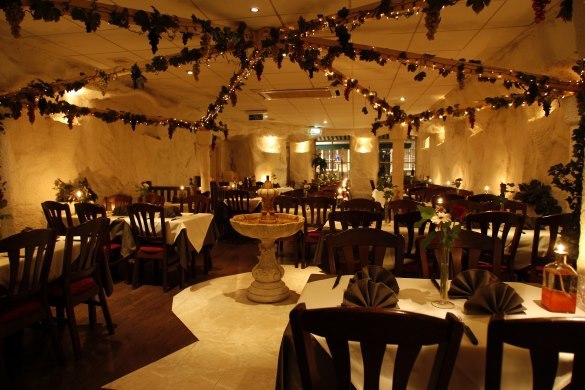
‘t Pannekoekenhuis Pannenkoek means pancake – the house specialty. The menu features unusual ingredients and is experimental in nature. The restaurant is situated on a dike and gives customers a wonderful view of the river Ijssel and the ferry.
Situated on one of the many canals Giethoorn has to offer, and within walking distance of most attractions, this authentic three star hotel is a real gem. The décor has a modern flair while the staff is especially welcoming and helpful.
With a modern exterior which belies its traditional 18th century interior, this centrally located hotel in Zwolle features a unique whisky bar – perhaps one of the best in the east of the Netherlands.

The history of Ballynahinch Castle, the 'household of the Island'
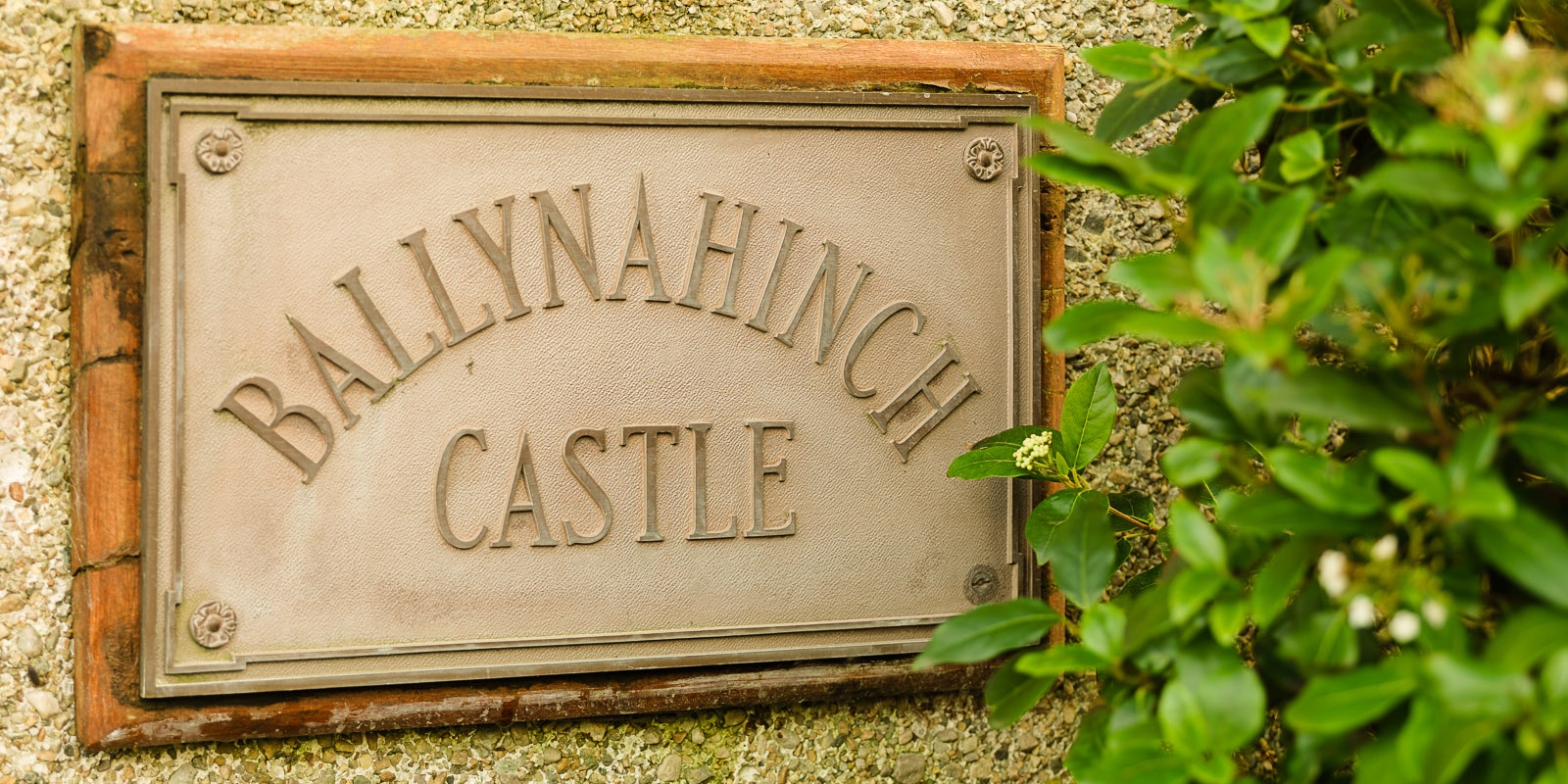
Ballynahinch Castle has been interwined in the history of Connemara and its people for centuries, from the recorded battle between the O’Flahertys and O’Malleys, in 1384, to the visit by all the Lord Mayors and Mayors of Ireland and some from overseas, to celebrate the Quincentennial year of Galway city receiving its charter.
Ballynahinch i.e. Baile na hlnse, means ‘household of the Island’, and refers to the O’Flaherty Castle built on an Island in the lake.
The O’Flahertys
The land of Lar Connaught stretched from the Castle at Bunowen and the plain of Murrisk in Mayo over to Moycullen on the banks of Lough Corrib. This was the land of the O’Flaherty Clan, lords of Connaught and masters of Ballynahinch. It was into this family that the most famous resident of Ballynahinch married; this was Grace O’Malley, the pirate queen of Connaught, who married Donal O’Flaherty or Dónal-an-Chogaidh (Donal of the battles). This was about the year of 1546 when Grace was sixteen. The marriage united two of the most powerful families in the country and bonded the lands of Murrisk and lar Connaught. Ballynahinch was just one of the many Castles the O’Flahertys held. The others were at Aughnanure, Doon, Moycullen, Bunowen and Renvyle.
Donal at this time was tanist or heir apparent to Donal Crone, ruler of all Connaught. Grace divided her time between Bunowen and Ballynahinch, Bunowen being the newer building of the two. She gave birth to four children and on the death of Donal (it was said that he was murdered by the Joyce Clan as revenge for the seizure of Hen’s Castle on Lough Corrib) Grace took over as head of her family – some said she was a better “man” than her dead husband. Her life as a pirate is well known, as is her famous meeting with Queen Elizabeth 1st in September 1593. These two formidable ladies met on equal terms as monarch to monarch. They spoke in Latin, and of the only Gaelic woman ever to appear in court it was written: “In the wild grandeur of her mien erect and high Before the English Queen she dauntless stood.” The mystery of where her last resting place is has never been solved but it is generally thought to be Clare Island in Clew Bay. She died in 1603 – the same year as Queen Elizabeth the 1st.
In 1584 the Queen appointed Murrough-ne-Doe O’Flaherty as head of the Clan against the wishes of the vast majority of the O’Flahertys, thus causing a split in the clan. In this same year Murrough-ne-Doe captured the fortress of Ballynahinch, but Grace’s sons, Owen and Murrough, recaptured it later in 1584. Murrough, son of Grace, retained possession of the castle until early in the seventeenth century. A sad footnote to the O’Flaherty connection with Ballynahinch – In 1586 Sir Richard Bingham, governor of Connaught, and arch-enemy of Grace, appointed his brother Captain John Bingham as a lieutenant of the area. In the same year, 1586, Captain Bingham, with 500 men, captured Owen O’Flaherty and eighteen of his followers, along with four thousand cattle, five hundred stud mares and horses, and a thousand sheep. With the livestock and men, he went to Ballynahinch.
A contemporary account describes Owen’s last hours. “That evening he (John Bingham) caused the said eighteen persons without trial or good cause, to be hanged. The next night following a false alarm was raised in the camp in the dead of night, the said Owen being fast bound in the cabin of Grene O’Molloy (Grace O’Malley) and at that instant the said Owen was cruelly murdered, having twelve deadly wounds, and in that miserable spot he ended his years unfortunate days.” Now if anyone has a good reason to haunt the Castle it is Owen O’Flaherty. The connection with Grace is kept to this day with a portrait of her by American artist, Cleeve Miller, which hangs in Fisherman’s Pub. The decline of the O’Flaherty family towards the end of the sixteenth century is marked by their recognition of the Queen’s Lord Deputy. In 1590 Robert Martin bought their estate at Ross outside Galway.
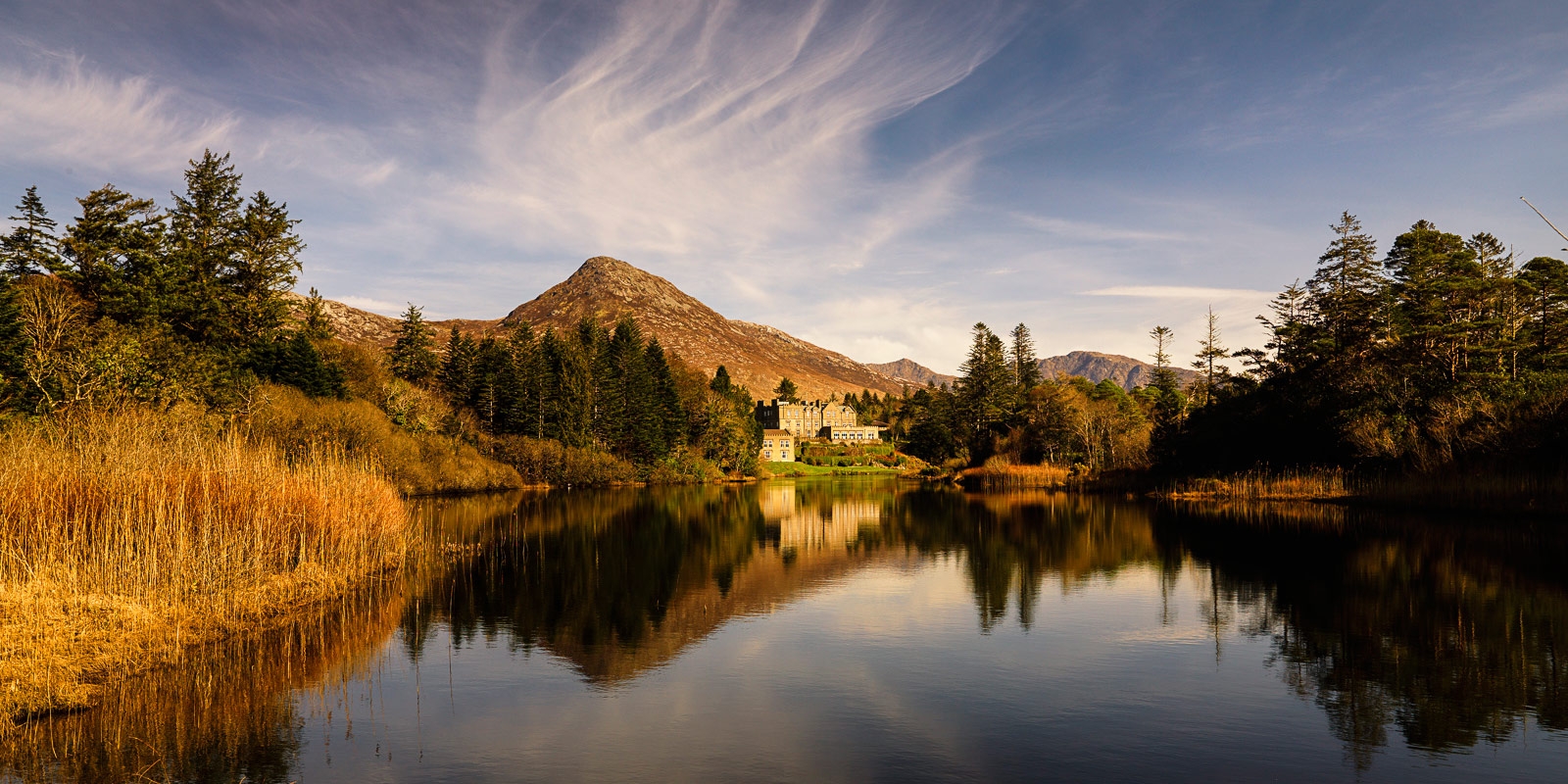
The Martins
The Martins trace their ancestry back to the Crusader, Sir Oliver Martin, who received his armorial bearings from Richard the Lion-Heart, with the pious motto: “Auxilium Meum Domino”. He came to Ireland with Strongbow during the Norman invasion in 1169, and settled for a while in Limerick. His family established themselves as one of the Fourteen Tribes of Galway. The Martins were the first of the tribes to venture outside the safety of the walled city of Galway. The O’Flaherty’s still kept a jealous eye on the Martins after they had sold to Robert, and in later years they were to kill a son of Nimble Dick, a great grandson of Robert, who lived at Dangan on the (then) outskirts of Galway. It was in that house that Richard Martin, “Humanity Dick”, was born in 1754.
The present house at Ballynahinch was built by Richard’s father as an inn, so history repeats itself and has come in a full circle once again. The house was extensively renovated about 1813 and Humanity Dick moved there permanently. Hardiman recorded in 1820 –
“Dangan of late years has been suffered to go to considerable decay”
This move thereby made Ballynahinch the principal seat of the Martin family. Richard Martin was indeed a most colourful man in the mould of his good friend the Prince Regent, later King George IV. His lifestyle was opulent and he was well known for his lavish parties – which later contributed to his money troubles. He was also known for his duelling skills which earned him his second nickname, “Hair-Trigger Dick” He was the leading exponent of duelling in Galway, and prior to each encounter he would display an old wound to his opponent with the comment –
“Let this be your target, Sir”
His opponents were never on target but he usually was. Ballynahinch Castle was host to many famous people during the early part of the nineteenth century. Maria Edgeworth, author of “Castle Rackrent”, was one such visitor in 1834, and on arrival was personally brought a glass of port by her host. Of the food at Ballynahinch Miss Edgeworth made the comment –
“It is worthy of the greatest gourmet”
Hopefully, if she returned today, she would say likewise. Daniel O’Connell stayed a night and had lunch the next day before going to Clifden to address a Repeal meeting. The story goes that he spoke to the throng in English and only about 30% of them understood him. One hundred years later Eamon de Valera came to Clifden and addressed the crowd in Irish, and, as before, only about 30% of the listeners understood him!
In his travel log, “An Irish Sketch Book”, W.M. Thackeray wrote –
“O you who laboriously throws flies in English Rivers, and catch at the expiration of a day’s walking casting and wadeing two or three feeble little trout of two or three ounces in weight, how you would rejoice to have but one hour’s sport on Derryclare or Ballynahinch; where you have but cast, and lo! A big trout springs to your fly”.
And, also, it is nice to think that if Thackeray were to fish here again today he would not go away disappointed. One other notable visitor at this time was tutor to the Martin children who fell hopelessly in love with Richard Martin’s wife, Harriet, - he was one Theobald Wolfe Tone. Richard Martin was M.P. for the area, and during one election campaign he called on his duelling for the answer to the question of who was going to win. His reply was –
“The survivor, Sir”
As M.P. he introduced a bill to the House of Commons in 1822, the “Cruelty to Animals Act”. As a result of the bill being passed the Society for the Prevention of Cruelty to Animals was formed, and it is for this reason that Richard Martin is most fondly remembered as “Humanity Dick”. It was a final gesture on his part for, not long after, he lost his seat at Westminster. It was at this time, under pressure from creditors, that he left Ireland, never to return for he died in Boulogne, France, in 1834. Asked on his death bed why he was so kind to animals and so ruthless to humans his last words are reputed to have been –
“Did you ever see an ox with a pistol?”
Then he died, and thus passed on the king of Connemara, the master of Ballynahinch, and the man who owned the longest driveway in the world –
“Forty one miles from Galway to his front door at the Castle”.
Richard’s Town house in Galway still stands in Quay Street, it is now occupied by Naughtons pub and in the first floor, the aptly named “Humanity Dick’s” Restaurant. After the death of Thomas Martin (Richard’s Heir) who died of famine fever, the heavily encumbered estate was left to his daughter Mary (a prolific novelist). She left the country to avoid the debts and died in The Union Place Hotel, New York not long after her arrival in America. Her death was brought about by the anxious voyage and the birth of a child in board the ship.
The Martin family had other notable members in more recent times. One was Violet Martin of Ross House near Oughterard. Under the pen-name of Ross she became famous as half of the literary partnership of Somerville and Ross, who wrote the “Irish R.M.” stories. Another was the writer Edward Martin of Tullyra Castle, near Loughrea, Co. Galway. Along with Lady Gregory of Coole and the poet W.B. Yeats he founded the Abbey Theatre in Dublin, and it was as a result of his generous patronage the Palestrina Choir of the Pro-Cathedral was founded.
After the Great Famine the Martins huge estate was sold up through the Encumbered Estates Court. The purchasers, the London Law Life Assurance Company of London, later sold it to Richard Berridge. It was the Berridge family who restored and enlarged the Castle to its present day structure. The Berridges were highly respected landlords, and were most kind and considerate to all their tenants. The lakes of Upper and Lower Ballynahinch, Derryclare, and Lough Inagh were all part of the estate. This continued up to the mid-fifties when a vast part of the lands were sold during the ownership of Mr. Noel Huggard.
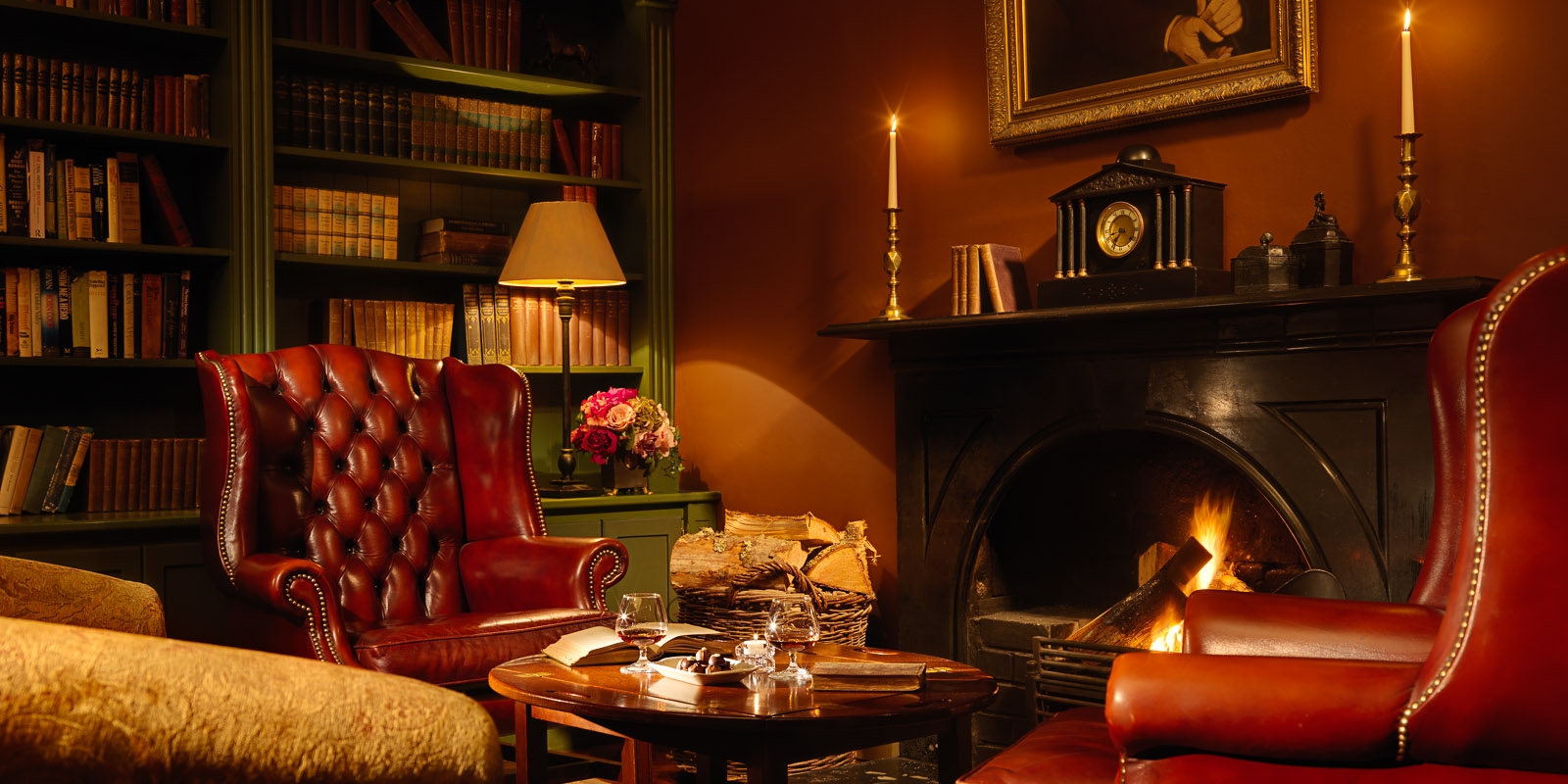
“Ranji”
After the Berridge family the Castle passed into the hands of His Highness the Maharaja Jam Sahib of Nawanager, better known as Ranjitsinhji, or Ranji Prince of Cricketers. Ranji had come to know Ballynahinch through its famous fisheries and in 1924 he purchased the property from the Berridge family. He had fallen in love with the beautiful and rugged scenery of Connemara, and wished to own part of it. It was Ranji who was responsible for most of the landscaping of the gardens and woods, plus the erection of the fishing piers and huts along the river. He was a fabulously wealthy man, having property in England, and, of course, his many palaces in India. He is best known as a world class cricketer and is regarded as second only to the legendary W.G. Grace, of whom Ranji was a team mate. He still holds many cricket records, and has two mentions in The Guinness Book of Records, which have yet to be broken.
But it was Ballynahinch which granted him most pleasure in his later years. He arrived every summer, around June. In Galway before coming to Ballynahinch he would buy five motorcars, two limousines and three smaller cars, and when leaving for India in October, he would give the cars to the locals as gifts – one maybe to the parish priest, to the local vicar, etc. and this was done each and every year! The avenue up to the Castle was covered with marble chips, which were raked every day. Each year on Ranji’s birthday a party was held for all the staff who worked for him. The party was held in the billiard room (the present day bar). He served the guests himself, and had a truck outside the door to take home the by now well-intoxicated staff. He had his own train carriage from Galway to Clifden, stopping off at Ballynahinch station (the Galway-Clifden line closed down in 1936) and as he neared the station, the locals placed fire crackers on the line as a sign of welcome. The locals and his many Indian servants seemed to co-exist happily, and two of his nieces went to school at nearby Kylemore Abbey. Due to a shooting accident in Scotland Ranji lost his right eye, and this injury ended any hopes of his carrying on his cricketing. He had a glass eye, and, in one of his palaces in India, one can see five spare glass eyes on display.
When word got back to Ballynahinch that he had died of an asthmatic attack the locals did not believe it as the date was April 1st, 1932, All Fools Day! This time it was no joke, but the truth. In September 1983 one of the most famous gillies ever to work in Ballynahinch died. His name was Frank Cummins. The day before he died he was still remembering fondly the pair of ruby cufflinks that Ranji had given him over fifty years before. The kindly Indian Prince still lives fondly in the memories of the locals old enough to remember the Prince of Cricketers.
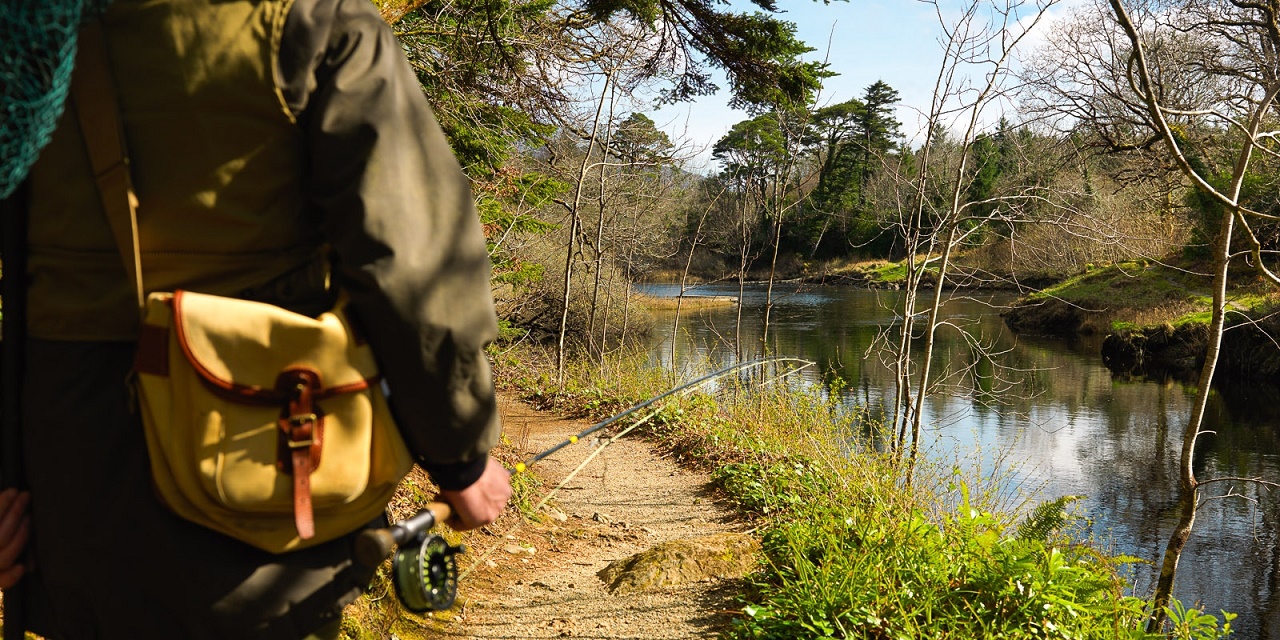
Modern Times
After the death of Ranji the Castle passed into the hands of his nephew Dulipsinhji who sold it to the McCormack family from Dublin. It was in 1946 when the Tourist Board took possession that the many years of private ownership came to an end.
This takeover gave a new lease of life to an old House, for it was insured that Ballynahinch Castle did not go the way of so many other stately houses, either being burned to the ground or stripped of its materials, as happened in the Castle of Dunsandle house, and Smiths of Maysinbrooke. For the first time the world famous fisheries were open to the public, and they took advantage of it. During this time the Castle played host to Eamon de Valeria. His signature is the first to be seen in the old visitors’ book. The writer Liam O’Flaherty was a regular visitor. Sir Alec Guinness, the actor, also stayed here, as did many other celebrities. The Irish Tourist Board (the forerunner of Bórd Fáilte) held the Castle until the early nineteen fifties when Mr. Noel Huggard took over the running of the Hotel in conjunction with Ashford Castle. From a tourist Guide in 1954 we can now see how prices have changed since then –
“Fully licensed: From 10 to 11 guns. B & B from 16/-; Meals: Lunch 6/- to 7/-; Tea 2/6 to 3/6; Dinner 10/6 to 12/6; (5 private bathrooms). Dogs not allowed.”
It is nice to think that we still have guests who first came in those days. The slight rise in prices does not seem to deter them. As was stated before Mr. Huggard disposed of a large part of the estate, including the fisheries of Inagh and Derryclare, and sold Ballynahinch Castle and Fishery in 1957 to an American businessman, Mr. Edward Ball. Mr. Ball in turn sold turn sold shares in the Castle to many friends and business associates. In 1978 when Mr. Ball was 89 and no longer traveling overseas he resigned as president of the corporation and nominated Raymond Mason for that post. Under his direction the Castle has undergone extensive renovation, and all-round standards have been improved. In 1981 the former President of America, Mr. Gerard Ford, and his wife Betty were guests of the Masons at Ballynahinch, as was former British Prime Minister James Callaghan. Ballynahinch has seen many changes since the days of “the ferocious O’Flahertys” over 700 years ago. It has been the home to many great and generous people. It has seen hardship – during the Great Famine of 1847 it was shelter for many starving people; it has seen great opulence and lavish parties; but, no matter what was placed in front of it, it lived on, and today the Castle takes a well-deserved rest as a leisurely retreat for the fisherman and a relaxing Hotel which caters for its Guests in a way that is personal, professional, and with the friendly Connemara touch.
Stay at Ballynahinch Castle on our Deluxe Connemara or Burren Islands and Connemara Bike Tours
Reproduced with kind permission of Ballynahinch Castle and Des Lally.
How centuries of census records were destroyed
Was it the most despicable act of cultural vandalism ever perpetrated in the name of Irish freedom, or just the most unfortunate piece of collateral damage wrought by a savage civil War? A century on, the destruction of priceless documents in the Public records Office remains a matter of hot dispute.
In April 1922, six months after the Anglo-Irish Treaty brought the War of Independence to an unsteady end, 200 anti-Treaty IRA men took over the Four Courts. Bedding in for a long siege, they aimed to force the British back to arms, which they hoped in turn would reunite the pro- and anti-Treaty Irish camps. Late June arrived with the rebels still dug in. The British, with thousands of troops still in Ireland awaiting evacuation, pressurised the pro-Treaty side to take action.
Fearing threats of a terrifying new, scaled-up British invasion, the Provisional government of Arthur-Griffith and Michael Collins had to get tough. On June 27th, the rebels were given an ultimatum to get out – or else.
A great deal of what happened over the next 48 hours is hazy. Most historians believe Collins gave the order to open fire with rifles and artillery, but others dispute this. Anti-Treatyites claimed they were preparing for an 8am evacuation when the bombardment began around daybreak. The rebels’ position was hopeless, but several hours before they surrendered a massive explosion shot a towering mushroom cloud into the sky. Raining down on the Liffey like black snow were the fitters of countless pages documenting Irish history, some dating back to the 13th century.
The blowing up of the Public Records Office destroyed the Irish census returns of 1821, 1831, 1841, and 1851. Most of the wills and testamentary records that had ever been proved in the country were incinerated, along with more than half of all the Church of Ireland records dating back to the establishment of Ireland’s Anglican church. Centuries of unique law court and local government records went up in smoke.
The recriminations and conspiracy theories continue to this day. Some think the records were wantonly destroyed as another nailing the coffin of the British rule, while others have claimed the records Office was booby-trapped to kill Free Staters reclaiming the building. Perhaps the most widely held view is that smell hit two truckloads of gelignite in the rebels’’ ammunition store, making the catastrophe an unhappy accident.
Reproduced by kind permission of Irish writer Damian Corless. Follow Damian on Twitter or see his website for for details on many related titles he has published.
And if you are interested in history and genealogy and want to know more, consider having a look at our Genealogy and Bespoke tours !